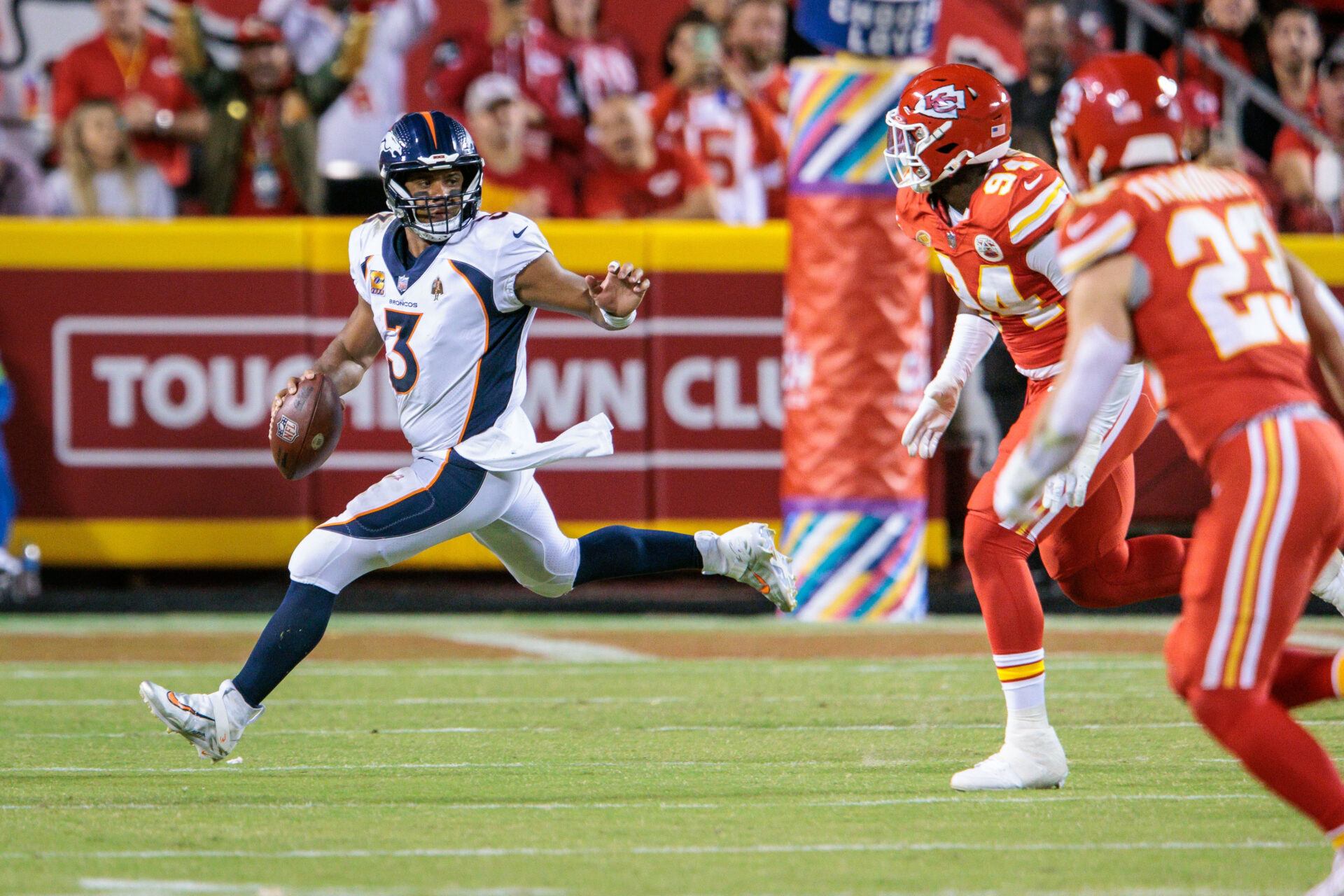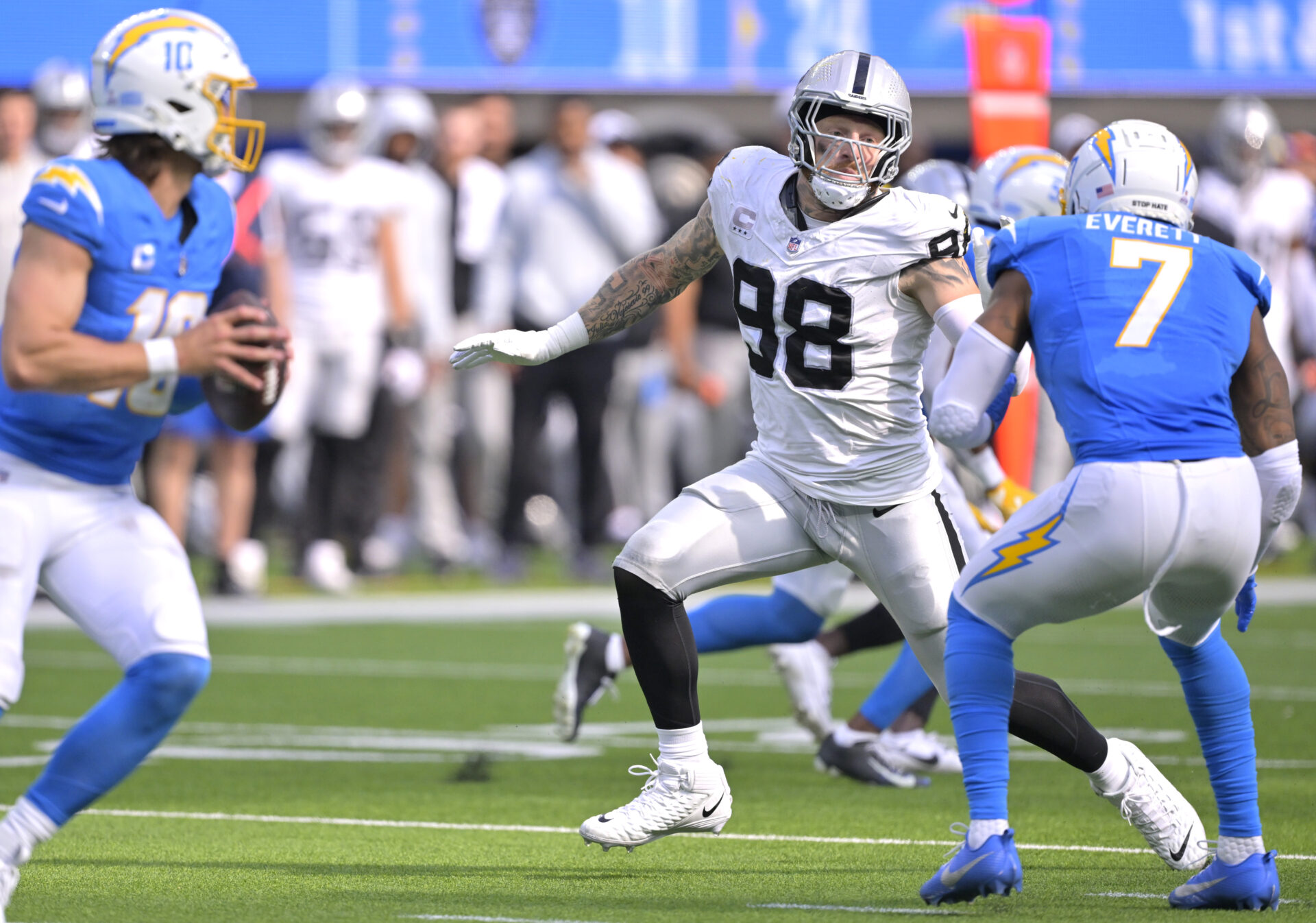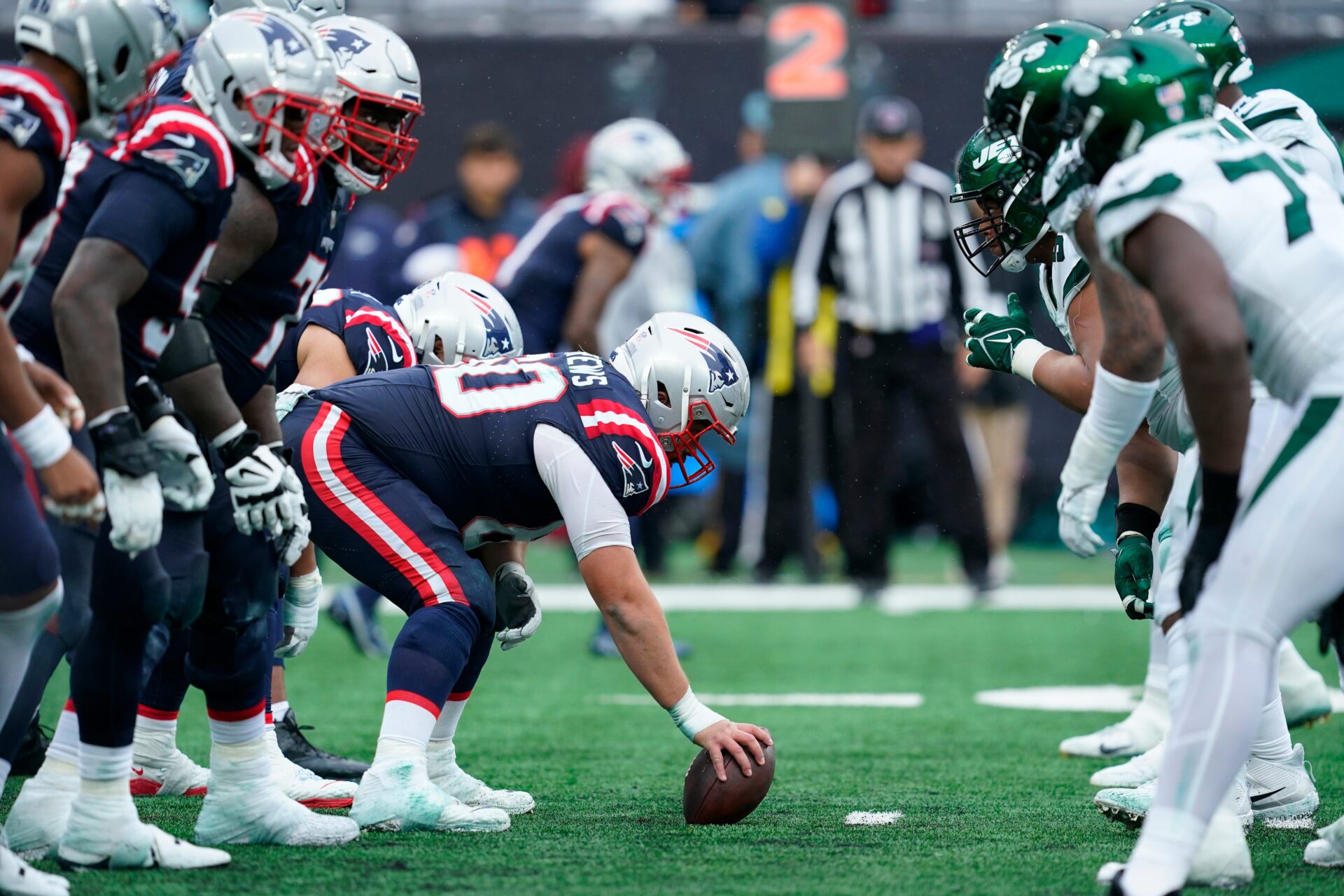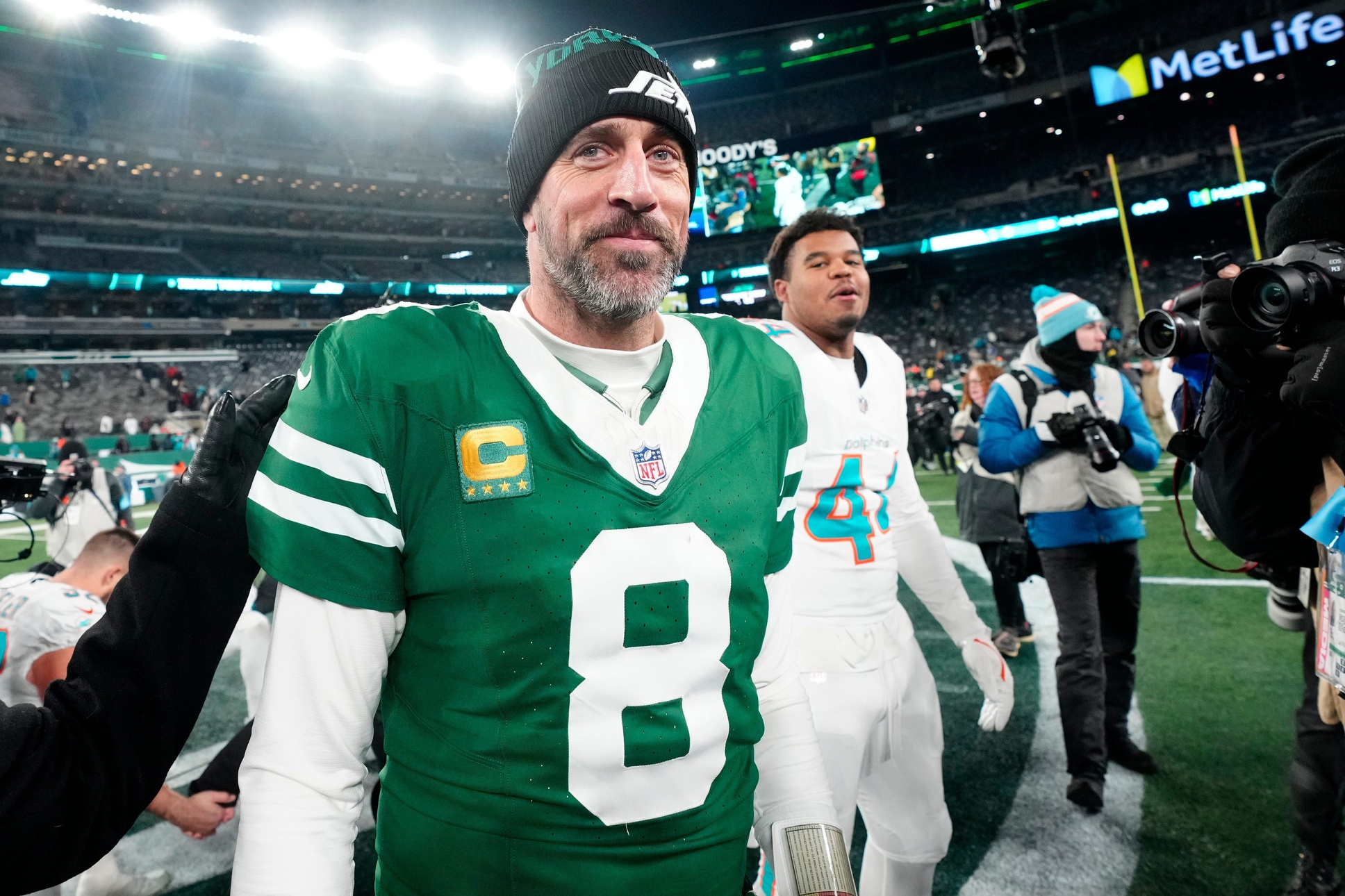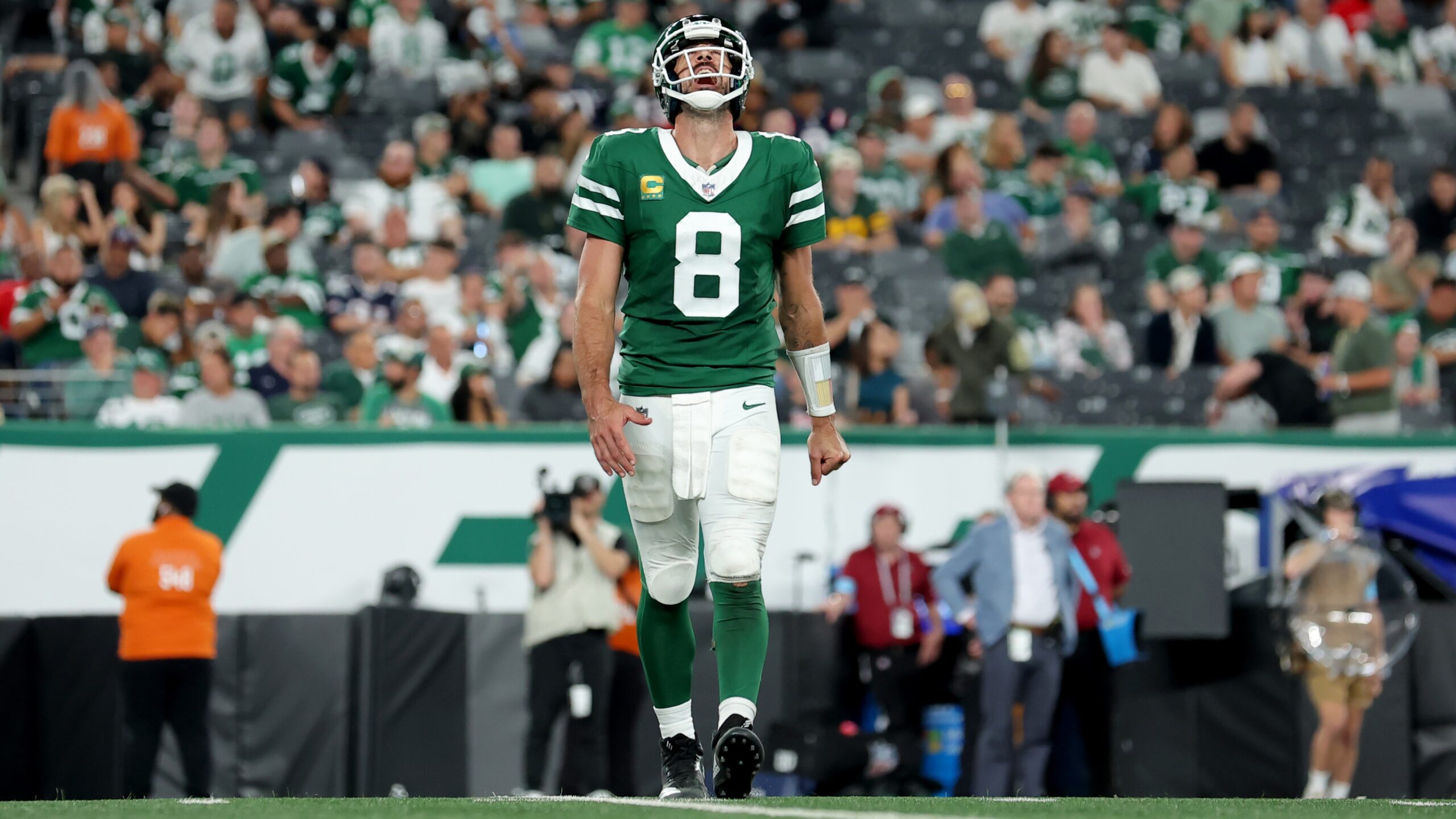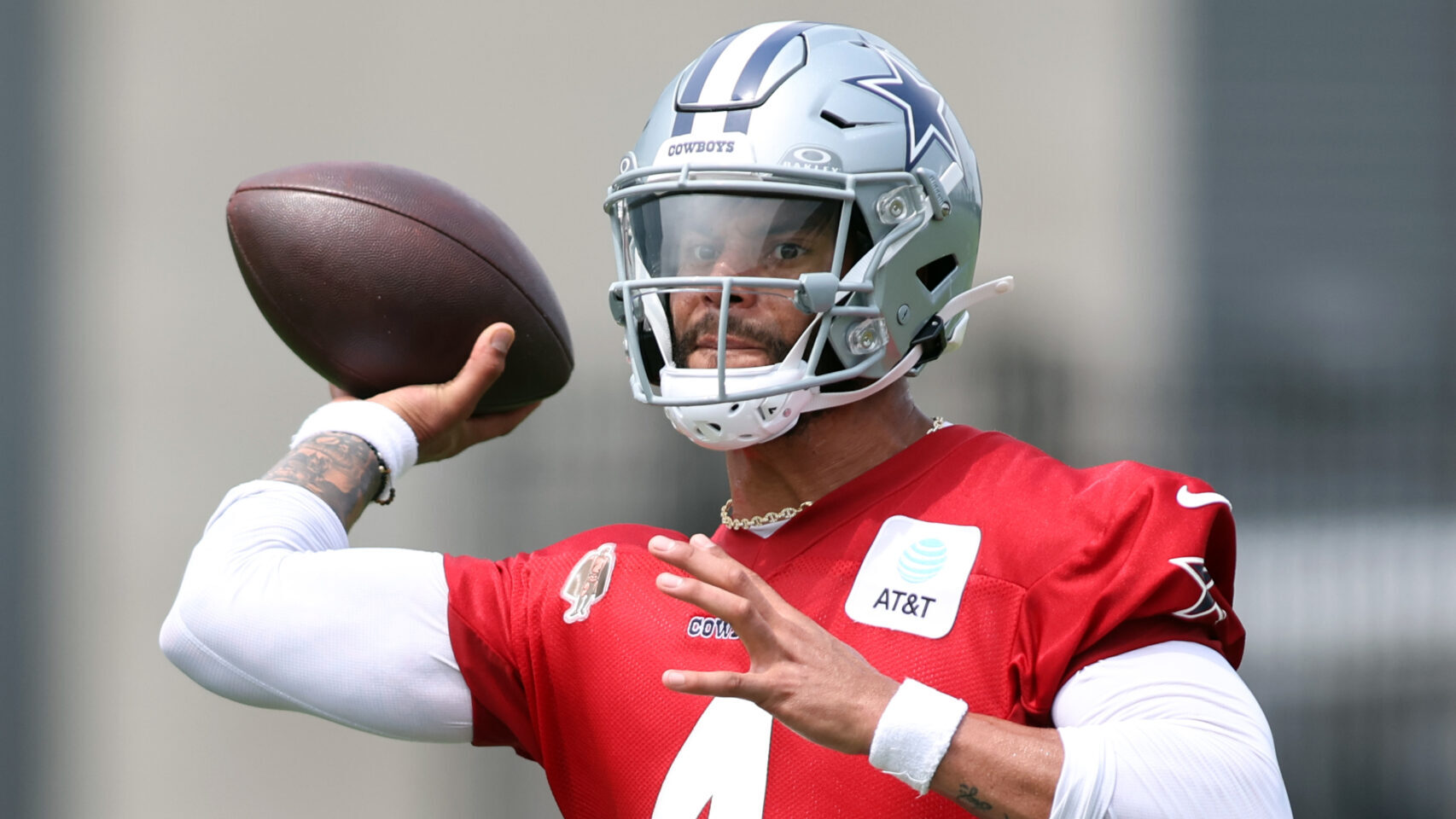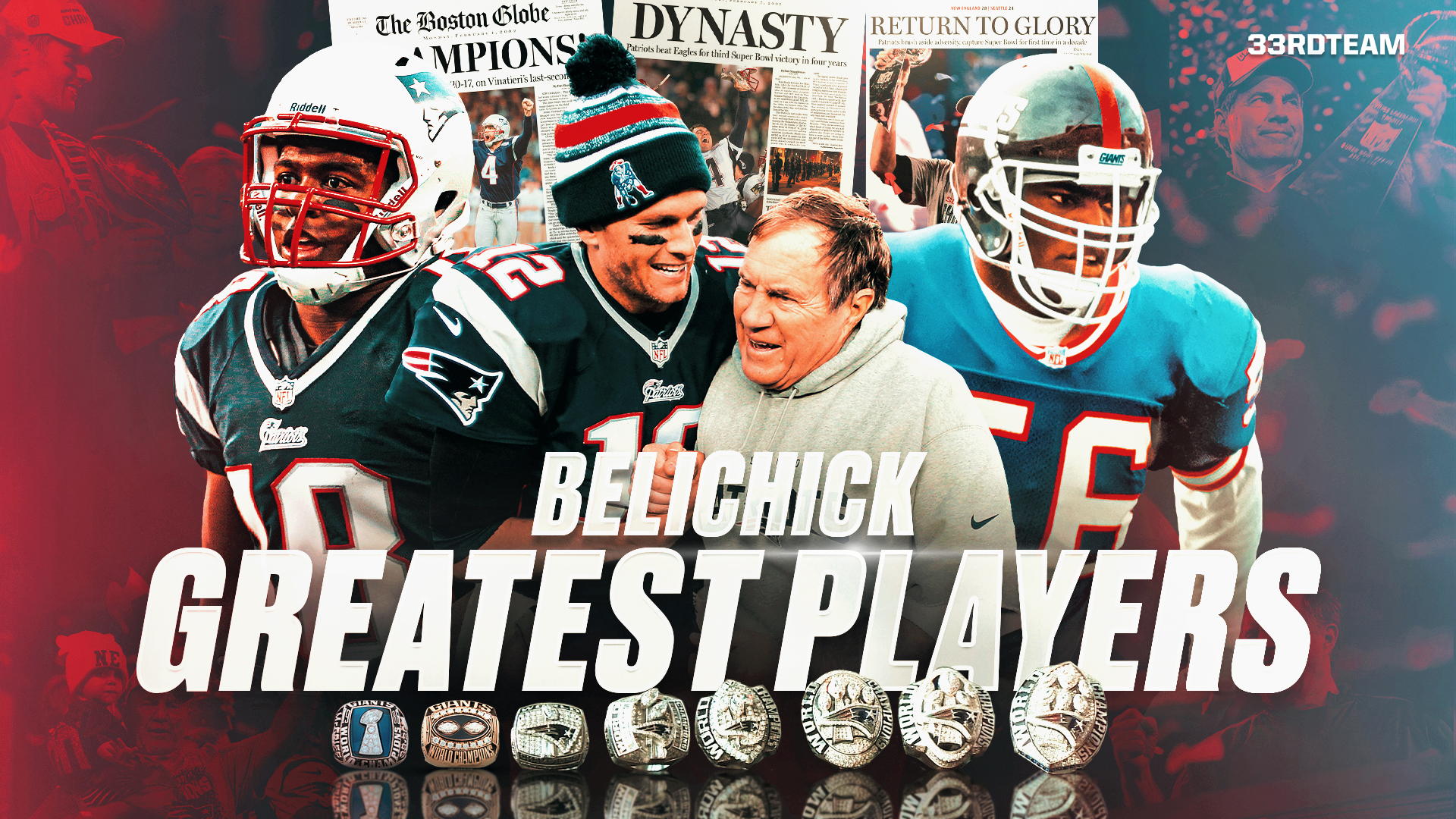Analysis
10/13/23
16 min read
What Has Happened to NFL Offenses?
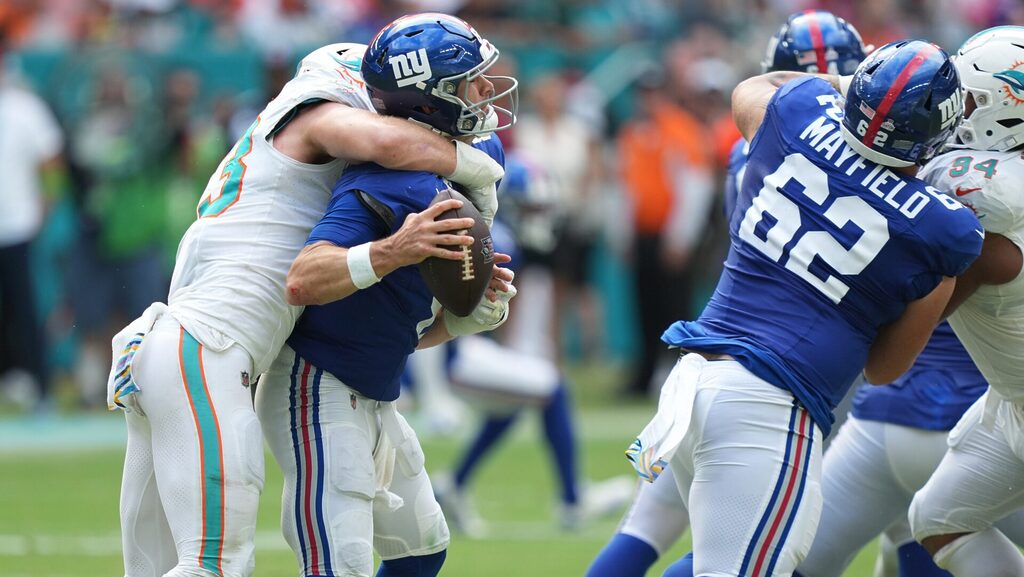
The first five weeks of the 2023 season have been tough on many of the league’s quarterbacks.
They’ve been sacked 412 times already, the most through five weeks since 2013. Thirteen teams currently are on pace to give up 50-plus sacks, including two – the New York Giants and Washington Commanders – who are flirting with the century mark. The Giants have given up a league-high 30 sacks, the Commanders 29. Last year, just four teams gave up 50-plus sacks.
Quarterbacks have been pressured on 35.3 percent of their dropbacks, according to TruMedia, which is the third-highest pressure rate since 2000. Seventeen quarterbacks already have been pressured at least 60 times. Through five weeks last year, just four quarterbacks had been pressured 60 or more times.
The heavy pressure on quarterbacks has contributed to the league’s lowest yards per attempt average after five weeks (7.0) since 2010. The league’s yards per play average (5.3) is tied for the lowest since 2008.
The 9.7 quarterback knockdown percentage (sacks+QB hits divided by pass-blocking snaps) is the highest since 2013. The pass-rush win rate is 44.7 percent, the highest since 2001.
There seldom is a simple answer to explain why something happens in football. It’s never just one thing. And that’s the case with the dramatic increase in sacks and pressures this season.
It’s a little bit of this and a little bit of that. It’s inexperience at the quarterback position. It’s the increase in mobile quarterbacks who tend to hang on to the ball longer. It’s a lack of offensive line depth.
It’s better pass-rushers, both inside and outside. It’s the fondness of offensive coordinators for empty sets and spread-‘em-out football.
It’s the league-wide trend toward not playing starters in the preseason. The popularity of two-deep shells by defenses around the league has forced offenses to use double-digit-play drives to try and get into the end zone.
Here’s a closer look at some of those reasons for the rise in sacks and pressures in the first five weeks:
Struggle of NFL Offenses
 Quarterback Inexperience
Quarterback Inexperience
The last three years have seen a number of veteran quarterbacks call it a career. Tom Brady. Philip Rivers. Ben Roethlisberger. Drew Brees. Matt Ryan. Ryan Fitzpatrick. Aaron Rodgers didn’t retire but tore his Achilles in Week 1 and is out for the season. That’s a lot of hard-to-fool experience.
Eight starting quarterbacks entered this season with 10 or fewer starts, including rookies Bryce Young (Carolina), C.J. Stroud (Houston) and Anthony Richardson (Indianapolis). Seven other starters had 35 starts or less on their resumé.
“A lot of great veterans have left the league the last few years,’’ said Charles Davis, an analyst for The NFL on CBS and a contributor for The 33rd Team. “We’ve got younger quarterbacks running around. Do they pick up the blitzes? Do they sense the scheme? Do they get rid of the ball fast?’’
“How many quarterbacks in the league can set the protection up front and understand what’s happening and then have the ability to quickly process it and get the ball out before they can get hit?’’ said former NFL general manager Mike Mayock, who is a game analyst for Westwood One radio this season.
“Guys like Brady and Matt Ryan, those kind of guys over the years were so good at it. Peyton Manning might’ve been the best. If those guys knew they were screwed, they just got the ball out.’’
Defensive coordinators like to blitz a little more against younger quarterbacks who still may be adjusting to the speed of the NFL game. Seven teams have blitz percentages above 35 percent this season, per Pro-football-reference.com.
That’s six more than last year. But there’s been no noticeable increase in the league-wide blitz percentage. It’s 26.5 percent this season compared to 26.1 last year, according to TruMedia.
Going Mobile
Pocket passers pretty much have gone the way of the dinosaur. The league is flush with dual-threat quarterbacks. Thirteen quarterbacks already have rushed for at least 100 yards. Twelve have 20 or more rushing attempts.
Quarterbacks that can run tend to hang on to the ball longer. The longer you hang on to the ball, the better the chances of you ending up on the ground.
“Guys that can run tend to hold on to the ball longer; that’s a fact,’’ said former NFL offensive lineman Brian Baldinger, an analyst for the NFL Network. “I played with Randall [Cunningham]. Those [mobile] guys get sacked a lot. Russell Wilson got sacked a bunch when he was younger."
“They’re going to move when they see color (the opposing team’s jersey). They’re going to move and run.’’
Many of the sacks of mobile quarterbacks aren’t your typical edge-rusher-beats-the-tackle sacks. They’ll often manage to evade that pressure, extend the play and get chased to the sideline.
“They’re getting flushed to the sideline and running behind the sticks and losing a yard or two,’’ Baldinger said. “I’m seeing a lot of those kind of almost flow sacks where guys are just getting chased and run out of bounds. I’m not sure why they don’t just throw it away. [The Giants’] Daniel Jones has been guilty of it a lot.’’
Jones has run the ball 38 times for 197 yards. That’s the third-most rushing yards among quarterbacks, behind only the Baltimore Ravens’ Lamar Jackson (265) and the Philadelphia Eagles’ Jalen Hurts (206). He’s also been sacked 28 times already, which is the second most in the league behind the Commanders’ Sam Howell (29).
“Mobile quarterbacks almost always have a higher sack rate because they don’t give up on a play,’’ Davis said. “They think, ‘I can always get out of it.’ Do they make big plays? Absolutely. But they also take sacks. I’m always astonished to see how much they’ve been sacked. They’re always thinking late in the play, ‘I’m going to make a play.’’’
Baldinger’s former Eagles teammate, Cunningham, rushed for nearly 5,000 yards during his career. He was also sacked 50-plus times in five seasons, including 72 times in 1986, the second most in NFL history.
Pass Rushers Are Better
Want to know why quarterbacks are getting sacked more and have less time to throw? Look at the guys who are hunting them down, said Mayock.
“You have to start the conversation with personnel,’’ the former Las Vegas Raiders GM said. “Over at least the last 10 years, we’ve been evolving more and more to a pass-first league. In the old days, and I’m talking as recently as five, six, seven years ago, when we were evaluating a defensive end or defensive tackle (his ability to handle) the point-of-attack run game was critical. It's just as important as the pass game. Now, it’s not. Now, it’s all about athletes who can get to the quarterback. How quickly they can get there."
“When you talk about edge rushers, we’re just drafting guys now who can get after the quarterback. It used to be that if a team had one talented edge rusher, they were fortunate. If you look around the league now, there are multiple teams with two – and even three – outstanding edge rushers."
“You look at Dallas, they’ve got two of the best (Micah Parsons and DeMarcus Lawrence). You look at Cleveland, they’ve [Myles] Garrett and Za’Darius Smith. The Chargers have Joey Bosa and Khalil Mack. The Eagles have [Haason] Reddick and [Josh] Sweat."
“And then you pair that with what I think is really big – the evolution of the defensive tackle. Fletcher Cox has been a dominant pass-rushing force inside for years. But they’ve got three young guys, the two Georgia kids (rookie Jalen Carter and second-year man Jordan Davis) and Milton Williams that are really, really good. All three of those guys can get up the field. They’ve got change of direction. They’ve got explosion."
“If you can pressure the quarterback from the inside, if you can get immediate pressure on the pocket, that disrupts everything. Even if he doesn’t get to the quarterback. Even if he doesn’t sack him. Just that immediate inside pressure disrupts everything."
“If you have multiple inside and outside guys who can get up the field with explosion and quickness, and just about every team does now, the other team has a problem. And it starts to force the other team into, what am I doing scheme-wise to protect my quarterback?’’
Nobody Home
Given the emphasis that defensive coordinators have placed on getting to the quarterback, given the growing number of freakish athletes playing on defensive lines around the league, you’d think offensive coordinators would spend a lot of time during the week trying to figure out ways to protect their quarterbacks.
You’d be wrong.
If you’re expecting a lot of 12- and 13-personnel groupings with seven and eight people staying in to block, fuhgeddaboudit.
A league that once scoffed at all of the spread offenses in the college game now has embraced the concept. Empty sets with five receivers going out on routes have become as commonplace as Patrick Mahomes television commercials.
“I’ve watched 12 or 13 games this week, and all I’ve seen is empty sets,’’ Baldinger said. “You’re asking your quarterback to pick a side. Pick the three-receiver side. Pick the two-receiver side. If they jump and cover the three-receiver side, you’re expected to come back to the two (receiver) side.
“But you can’t get there in these empty sets. (With rushers like) Nick Bosa, Maxx Crosby, T.J. Watt, Danielle Hunter, you can’t block those guys for 2 1/2 or three seconds. And now you’ve got these guys inside like Carter and Javon Hargrave blowing things up and getting in quarterbacks’ faces. (The Dolphins’) Christian Wilkins just completely blew things up the other day against the Giants.’’
The 6-foot-4, 310-pound Wilkins had seven pressures in the Miami Dolphins’ 31-16 win over the Giants, including one of his unit's six sacks of Jones.
“You’re asking these quarterbacks in these empty sets to get rid of the ball quickly,’’ Baldinger said. “That’s why the yards-per-attempt average is down. Because all they can do is get the ball out of their hand as fast as possible because there are five guys going out in routes.
“You have so many bad offenses right now like the Giants that can’t protect, can’t get the ball down the field, can’t really do anything. They don’t run the ball well enough to keep things balanced. These quarterbacks, all they’re doing is getting hit. I think we’re going to see more injuries at quarterback than ever before. No way Daniel Jones or Bryce Young or Anthony Richardson or any of those guys can survive the way they’re getting hit.
“Way too many empty sets, way too many spread formations. And these guys feel like that’s the best way to attack. Baltimore is guilty of it, even with their new coordinator (Todd Monken). And they’re on their third right tackle and have been playing without (left tackle) Ronnie Stanley. They played without (center) Tyler Linderbaum for a game or two. So they’ve had a lot of backups in there. T.J. Watt was going up against (Ravens backup right tackle) Patrick Mekari last week. Mekari is your basic utility guy. He’s not going to keep T.J. off Lamar.’’
Jackson was sacked four times in the Pittsburgh Steelers’ 17-10 win over the Ravens. Watt had two of those sacks and five total pressures. Jackson, who was sacked 26 times in 12 games last year, already has been sacked 15 times in five games this season.
“As offenses evolve and you have everybody running these spread offenses with empty sets, put yourself in the head of the offensive coordinator,’’ Mayock said. “He wants to get as many guys out in the route as he can.
“My dad, God rest his soul, was a former offensive line coach. He always used to laugh when he watched NFL games. He’d say, ‘You can protect the f---ing quarterback. You just gotta keep people in to block.’ So, coaches are making a conscious decision. They’re releasing everybody out (in routes) and that’s fine. But understand that your quarterback is going to get the s--- beat out of him. There’s a tradeoff.’’
Lack Of Offensive Line Depth
NFL head coaches are fond of saying “next man up’’ when asked how they’re going to replace a starter who has been injured. But that next man up had better be able to play.
Jeff Stoutland has been the Eagles’ offensive line coach since 2013 when he was hired away from Alabama by Chip Kelly. Stoutland, who doubles as the Eagles’ run-game coordinator, is one of the best offensive line coaches in the league. Nobody but nobody is better at developing players. He took a lump of Australian clay named Jordan Mailata, who had never played football, and turned him into one of the league’s better left tackles.
In 2020, injuries devastated the Eagles’ offensive line. Their five starters missed a total of 40 games due to injury. The team’s quarterbacks were sacked 65 times. That was the most sacks allowed in a season by the Eagles since 1987.
That disastrous 4-11-1 season made general manager Howie Roseman realize the importance of building offensive line depth. The fact that he had a teacher like Stoutland helped. The 5-0 Eagles not only have one of the league’s top offensive lines. They also have the best offensive line depth in the league.
But very few teams have the kind of depth up front that the Eagles have.
“Coaches, especially offensive line coaches, trust the older guys that know their protections,’’ Mayock said. “But over time, talent erodes and injuries take their toll. When I look at the depth charts of teams around the league, I often say, ‘Oh my God. That guy is still starting?’ He might’ve been cut four times and is 32-33 years old. But he knows the protections.
“There’s a ton of those kind of guys out there. And I ask myself, who’s developing the young offensive linemen? If you’re a first-round offensive lineman, you get multiple chances. But some of these guys who are third-, fourth-, fifth-round picks who are really talented, they’re not getting developed by a lot of teams. Coaches trust the veterans, even if many of them can’t win anymore on a consistent basis.’’
Baldinger, who played 11 years in the league, agrees.
“(Offensive line) depth is definitely down,’’ he said. “Very few teams are like the Eagles. Their right guard (Cam Jurgens) goes down and they plug in Sua Opeta, who has been in the system for four years, and he plays great. Helped shut down Aaron Donald last week. They can put (backup tackle-guard) Jack Driscoll in there and probably get the same type of play. And we haven’t even seen their second-round pick, Tyler Steen, yet. In most places, he’d be starting right now.
“Compare that to the Giants, who already have given up 30 sacks. Their line is a mess. They’ve got backups at every position. Ben Bredeson, you might want him on your roster, but you don’t want him playing center every snap. [Right guard Marcus] McKethan is a backup player. Their left tackle is a left guard. He’s not a tackle. The right tackle (Evan Neal) is barely suitable to play in this league. He’s OK if everything else is solid around him. But they just can’t function right now. Daniel Jones is getting splattered and having to run for his life.’’
Two-Deep Shells
As much as offensive coordinators love the spread offense and empty sets, that’s how much defensive coordinators love two-deep shells.
Don’t give up the big play. Make teams dink and dunk their way down the field. More opportunities for the young quarterbacks to make mistakes. More opportunities for second- and third-and-longs and letting your elite pass rushers go after the quarterback.
“Those two-high (safety) shells that defenses are playing to make people be patient and run extra plays, most of these young quarterbacks didn’t see two-high shells in college,’’ Davis said. “And the guys they were throwing to back in college were way better than the guys defending them. So, it didn’t matter what the defense was playing. They could push it and throw it and win.
“But now, in the NFL, that two-high shell guy, he’s really good. So, that becomes a problem for these young quarterbacks.’’
“The old cliché was that if you wanted to get a team out of a two-deep zone, you ran the ball,’’ Baldinger said. “You’d run them out of it. But you have to be good enough to handle a seven-man front, and not a lot of teams are. Good luck getting the San Francisco 49ers out of a two-deep shell.’’
Summer Rust
The top concern of NFL coaches when they open training camps in late July is trying to make sure they get their key players to the Week 1 starting line healthy. When the league increased the number of regular-season games from 16 to 17 in 2021, they also slashed the number of preseason games from four to three.
Many teams don’t even play their starters in any of the preseason games anymore, relying on a handful of joint practices with other teams to get ready for the season. This has resulted in some early ragged play.
“Cohesion loses early (in the season),’’ Charles Davis said. “Because it takes a while to get it all knitted together. Chaos wins early. And that’s defensive fronts. Yeah, they have rush lanes. But at the end of the day, their job is to create havoc and go beat someone up.
“Offensive linemen, they have to know what the guy next to them is doing. If you do this, he’s got to do that. And they come into these early-season games not having done much of that under live fire during the preseason. So there are going to be some mistakes made for a while.
“It’ll be interesting to see if the (sack and pressure) numbers change over the next few weeks. See if they settle down into a better pattern. But right now, it’s a go-get-‘em-quick thing. And the defensive linemen are winning early against a lot of these younger quarterbacks and against these offenses.’’
Paul Domowitch covered the Eagles and the NFL for the Philadelphia Daily News and Philadelphia Inquirer for four decades. You can follow him on Twitter at @pdomo.

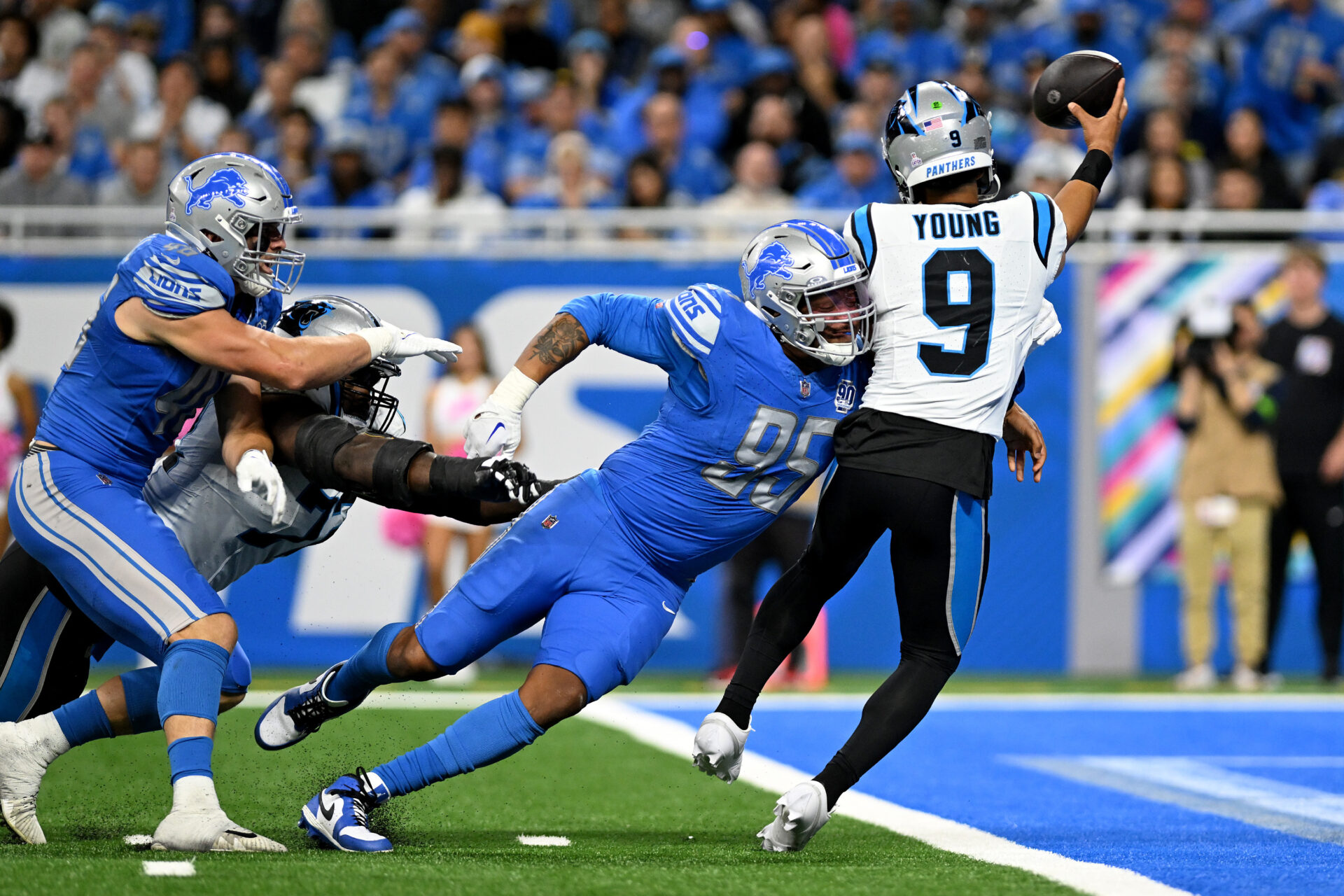 Quarterback Inexperience
Quarterback Inexperience